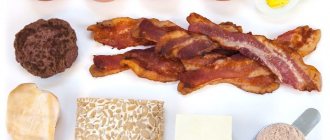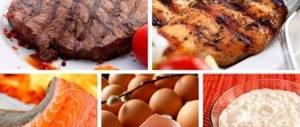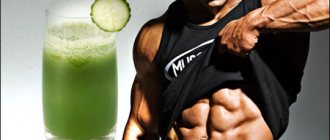Functions of proteins in the body
- The main function of proteins is construction . Protein is part of every part of the cell and extracellular structures. It is the source of cell construction and renewal. Without protein, organic life simply would not exist.
- Catalytic function of proteins . Not a single chemical reaction in a living organism occurs without the participation of enzymes or enzymes. These are protein molecules that serve as catalysts, speeding up all chemical processes millions of times. Moreover, each reaction requires its own special enzyme.
- Transport function of proteins . Proteins transport elements and compounds in the body. For example, hemoglobin delivers oxygen to every cell, and it also carries carbon dioxide.
- Motor function of proteins . All muscle movements in the body occur thanks to a special contractile protein.
- Protective function of proteins . As soon as foreign substances enter the body, special proteins - antibodies - begin to be produced that neutralize hostile elements.
- Energy function of proteins. Protein, of course, is involved in the body’s energy processes, but compared to fats and carbohydrates, it is the least effective as “fuel”. According to Academician Pokrovsky, who developed the theory of balanced nutrition, proteins provide 70.8% of energy, while fats provide 96.3%, and digestible carbohydrates provide 100%.
The role of proteins in the nutrition of athletes
Drawing up the right menu is the main key to slimness and a sculpted, seductive body. The role of protein in the nutritional system is fundamental. The right amount of protein will help you either lose or gain weight.
When exercising weekly, nutrition plays a huge role. So, after visiting the gym there is a period of time called the protein-carbohydrate window. Within an hour after active exercise, the body most needs to replenish spent energy.
For those who decide to lose weight, it is recommended to skip the post-workout snack. Thus, the body, trying to replenish energy reserves, begins to burn the hated fat. To increase muscle mass, on the contrary, it is necessary to make a snack containing protein-containing foods within 30–60 minutes.
Protein structure
The components of proteins are amino acids, which in turn include oxygen, hydrogen, carbon and nitrogen. In general, there are about 80 amino acids in nature, and only 22 of them are found in our food.
12 amino acids can be synthesized in the human body - these are the so-called non-essential amino acids. The remaining ten are essential and we can only get them from food. Proteins coming from food, depending on whether they contain essential amino acids or not, are divided into complete and incomplete.
Some scientists, however, consider this division controversial. In their opinion, a more or less varied diet provides the body with various amino acids in sufficient quantities. In addition, normally the intestinal microflora itself is capable of synthesizing them.
Serious metabolic disorders associated with amino acids occur only in certain diseases, insufficient or monotonous nutrition, as well as in the case of drug abuse.
Benefits and harms
Finding out which foods contain a lot of protein is important because a lack of this nutrient will lead to poor health and serious health problems. Because of this, the functioning of the endocrine system is disrupted, brain function also deteriorates, the composition of the blood changes, protective forces (immunity) decrease and endurance decreases.
People should consume protein-rich foods every day. The body will begin to compensate for its deficiency from its own reserves, by breaking down muscle protein, which leads to dystrophy.
Plant and animal proteins consist of essential and non-essential amino acids. The first ones (there are 8 of them) are not synthesized by the body; they come to us only with food. These amino acids perform many important functions, including:
- tissue regeneration;
- hemoglobin formation;
- participation in the process of hematopoiesis.
Protein is broken down into amino acids in the gastrointestinal tract, and most importantly, it is involved in almost all biological processes of the body. The peculiarity of protein is that the body absorbs it in the quantity it needs at the moment. The excess will simply be recycled. However, excessive consumption of foods high in this nutrient can be harmful, as can excess carbohydrates or fats.
Calcium is used to process “extra” protein. If this microelement is deficient, it will be taken from the bones, which will lead to the development of osteoporosis. An excess of protein foods creates a serious burden on the kidneys, which is the cause of various diseases. If your diet is based on animal proteins, you need to be aware of cholesterol and try to maintain its level within the established norm.
The body's need for proteins
The so-called “norm of consumption” of proteins is not actually the norm, since it depends on many factors, such as heredity, type of nervous system, age, physical and mental stress, climate, etc. The concept of norm here is strictly individual.
A growing body—children and adolescents—needs the greatest amount of protein, then the need for it begins to decline, and in old age protein already does more harm than good.
The body takes in exactly as much protein as it needs, excess proteins are “burned”, forming waste products - uric acid, urea, ammonia, creatinine, creatine, etc. When there are too many waste products, they begin to accumulate in tissues, causing various metabolic disorders.
Table of protein digestibility
Protein digestibility is an important indicator that allows you to understand how much protein from a particular product will be absorbed by the human body.
Incoming nutrients are not completely absorbed by the intestinal walls. This indicator depends on the composition of the product, the state of the intestinal microflora, the combination of products consumed, and the method of preparation. It is known that steaming allows for maximum preservation of micronutrients, and the presence of vegetables in the diet contributes to better protein absorption.
The highest quality protein product is considered to be the one whose digestibility coefficient tends to 1, and the amount of fat is minimal.
Proteins are divided into two categories:
- Fast (easily digestible) - complete proteins. They help the body produce energy, give a boost of vigor and strength, and allow you to gain muscle mass. Fast protein is absorbed by the body in 1-1.5 hours.
- Slow - all incomplete proteins. The assimilation process takes up to 8 hours.
Protein-rich foods, the nutritional value table of which is given below, have the highest digestibility coefficient:
| Product name | Protein/fat/carbohydrate content per 100 g | Protein absorption rate | Type of protein |
| Eggs | 13/12/1 | 1,0 | Fast |
| Kefir | 3/3/4 | 1,0 | |
| Cottage cheese | 17/5/0 | 1,0 | |
| Cheese | 25/20/0 | 1,0 | |
| Beef | 19/12/0 | 0,92 | |
| Chicken | 21/9/0 | 0,92 | |
| Pink salmon | 21/8/0 | 0,90 | |
| Lean pork/beef | 16/28/0 | 0,63 | |
| Soybeans | 35/17/27 | 0,91 | Slow |
| Beans | 22/2/55 | 0,68 | |
| Peas | 23/2/68 | 0,67 | |
| Buckwheat | 13/3/68 | 0,66 | |
| Rye | 11/2/56 | 0,63 | |
| Corn | 8/2/75 | 0,60 | |
| Oats | 12/6/65 | 0,57 | |
| Rice | 7/1/74 | 0,55 | |
| Wheat | 13/1/71 | 0,54 | |
| Peanut | 26/45/45 | 0,52 |
Milk, which is a fast protein, is often not digestible by adults. This is due to lactose intolerance, which is part of the drink. To create a balanced diet, it should be replaced with fermented milk products.
Examples of High Protein Foods
The daily protein requirement for women determines the direction of their nutrition.
To properly organize their diet, representatives of the fairer sex should focus on dishes that include:
- Eggs. A medium-sized product contains up to 17% protein. In addition, eggs have high biological value, supplying the body with nutrients and amino acids.
- Cottage cheese. Contains up to 14% protein. The advantage of the product in question over its analogues is the fact that more time is required for the body to absorb it. This allows a woman, having consumed cottage cheese before bed, to feel full all night and not wake up from a feeling of hunger or acute discomfort in the stomach in the morning.
- Milk. It is not recommended to give preference to low-fat versions of the product, since in this case the risk of losing some of the nutritional properties of milk after a multi-stage processing system increases.
- Cheese. Despite the high protein content - up to 30%, the cheese contains a large amount of fat, which increases the calorie content of the product and creates the need to control the amount of its consumption, especially for women trying to lose weight.
- Chicken or turkey. The optimal product in terms of the ratio of protein concentration and ease of absorption of the nutrient by the body.
- Young beef. No older than 2 years. Boiled or stewed beef is considered the healthiest.
- Liver. Contains up to 25% protein, which is the maximum possible in principle. In addition, the advantages of liver include its low cost and minimal amount of calories.
- Fish of white and red varieties. It is recommended to give preference to salmon, mackerel, tuna and steam the product to preserve the maximum amount of beneficial nutrients.
Synthesis
Protein biosynthesis occurs on the ribosomes of the endoplasmic reticulum. This is a complex process consisting of two stages:
- formation of a polypeptide chain;
- protein modification.
Synthesis of the polypeptide network occurs with the help of matrix and transfer RNA. This process is called translation. The second stage includes “working on mistakes.”
Parts of the synthesized protein are replaced, removed, or extended.
Rice. 2. Protein synthesis.
Interesting facts about protein molecules
- The main skin protein molecule, collagen, consists of two thousand amino acids. Collagen is responsible for the elasticity and strength of the skin. If the synthesis of this complex protein is disrupted, even the most modern and expensive creams will not be able to help.
- The body of a man weighing 70 kg utilizes about 100 grams of protein per day. The speed of this process is one million cells/min. And if you do not replenish the loss of protein through high-quality nutrition, then the destruction of internal organs gradually occurs.
- For obese people, abstaining from protein foods is especially dangerous. If a person with developed muscles has protein starvation, then his body takes the necessary amino acids from muscle tissue. If there is little muscle tissue and a lot of fat, then with a lack of protein in the diet, the body begins to use internal organs as a source of amino acids.
List of the healthiest protein foods
Protein is not the most important component in food. It is necessary to maintain a balance of calories, the ratio of BZHU, nutrients. Therefore, you should not consider the most useful products based on protein indicators.
Food of animal origin contains vitamins and beneficial microelements. For example, B1-B12. It is very difficult to replace the role of a group of vitamins with similar foods.
To do this, eat meat, dairy products, and otherwise, get the elements with pharmaceutical drugs. However, pills sometimes have a negative effect.
Therefore, the main rule of diet planning is moderation and balance. You need to include dairy products, eggs, meat, vegetables, seafood. Then the food will contain a full range of substances necessary for the body, and the diet will become more varied.
10 foods with the highest protein content
If we take a comprehensive list of all known available items, taking into account plant sources and products of animal origin, the following rating will be formed:
- food gelatin;
- ground mustard;
- soy;
- pumpkin seeds;
- black caviar;
- peanut;
- Red caviar;
- cocoa powder;
- cold and hot smoked sausage;
- cheese.
Will the following list of products help you create a complete diet? Most likely it won’t work. Or the person will get “protein poisoning” (a common type of illness during a resort stay when eating seafood). But consuming gelatin, mustard, and soy is difficult: there is a risk of injuring the digestive tract, and the taste buds will completely fail.
Therefore, the menu is compiled not only from champions in terms of nutrient content.
Plant products
Plant foods, along with protein, include significant amounts of carbohydrates.
Vegetable protein provides an incomplete spectrum of amino acids, so it is ideal to use such products as a side dish for meat or poultry. This is a great way to increase your protein intake, as well as fiber and a range of vital minerals.
- Lentils . In addition to protein, lentils are a source of iron, molybdenum and folic acid, which are necessary for the functioning of muscle fibers.
- Buckwheat . A healthy product that improves blood circulation, lowers cholesterol and controls blood glucose levels.
- Legumes . Soybeans, beans and peas are rich in protein; soybeans are even higher in protein than meat. Add legumes to soups, salads and side dishes with meat dishes.
- Tofu . Soy cheese is a concentrated source of all the proteins provided by soy. It can be added to salads, grilled or fried with eggs.
- Quinoa . This whole grain contains iron, magnesium and manganese in addition to protein.
- Nuts . Walnuts, cashews, almonds, along with their high protein content, are rich in healthy fats. Choose small quantities of unsalted nuts for a snack or to add to a salad.











